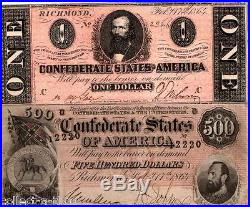
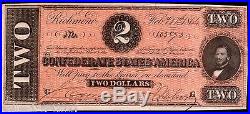
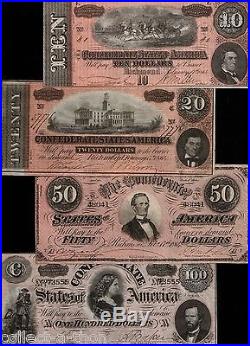
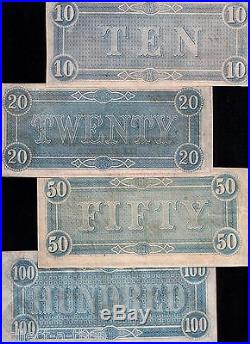
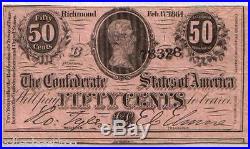

KEEP IN THE PINK. This collection of guaranteed original Confederate currency will do just that. 50c by Archer & Halpin Richmond, 1st Series Bust of Jefferson Davis. Signed by Robert Tyler, Register and son of U. Choice Crisp About Extra Fine with extra shelvege on right and bottom. Choice Crisp Uncirculated, would be Gem with more margin on left. Ultra rare this nice! Will be included in the deal! RMT Hunter Secretary of War right, Horses pulling Cannon into battle center. 2 digit serial number! Cut right along border at top right, otherwise quality of Gem Crisp Uncirculated. AH Stevens Vice President right, Nashville State Capitol building center. Choice Crisp Uncirculated, almost Gem! Darker Red with a slight purple tone. Choice Crisp About Uncirculated with nearly perfect centering. Whisper light center bend (visible at an angel) away from Gem! Randolph right, Lucy Pickens center, Confederate soldiers left. Rich pink with slight lavender tone. Very Choice Crisp Uncirculated. Portrait of Stonewall Jackson right, CSA flag and arms left. Very Choice crisp XF-AU, looks Uncirculated on front. Someday this bill will be worth our price for the whole collection! These 9 notes are all RARE in the offered grades. Seldom will a whole set of them show up so nicely preserved!! Don’t miss this once-in-a-lifetime opportunity from Collect-a-thon, home of hundreds of historic CSA banknotes and bonds!! DEPICTING JUDAH BENJAMIN, THE MOST PROMINENT. OF THE 19th CENTURY. It is DEEP ORANGE and bears the portrait of Judah Benjamin. His unique story appears below. The eye appeal, paper condition and color more than make up for this deficit. Price is half the going rate for a Gem! A simply spectacular CSA deuce! In this 1866 lithograph of Jefferson Davis and the first Confederate Cabinet, Judah P. Benjamin, second from left, is seated closest to the Confederate president. Benjamin was known as “the brains of the Confederacy, ” its “court Jew, ” “the statesman of the Lost Cause, ” and even the Confederate Kissinger. As, successively, attorney general, secretary of war and secretary of state in the Confederate Cabinet, he was President Jefferson Davis’ closest and most trusted adviser. He has been called the most important Jew in American public life in the 19th century: the first acknowledged Jew to serve in the U. Senate and the first Jew to be offered a seat on the Supreme Court, an offer tendered by President Millard Fillmore, and declined by Benjamin, just a few years before the birth of Louis Brandeis, who in 1916 would become the first Jew to serve on the High Court. And, as Supreme Court Justice Ruth Bader Ginsburg noted in a 2002 lecture at Loyola University School of Law in New Orleans, Benjamin’s political career was “bracketed by two discrete but equally remarkable legal careers, the first here in New Orleans and the second in Britain, ” to which he made his spectacular escape, posing as a foreign peddler, after the Confederate cause was lost. Even in Louisiana, “very few people have heard of Judah Benjamin, unless they are Jewish or Civil War buffs, ” said Laura Cassidy, a fifth-generation descendant of Benjamin through his sister, Rebecca Benjamin Levy. In an effort to help rectify that, the Louisiana State Archives, 3851 Essen Lane. In Baton Rouge, will be hosting an exhibit, Judah P. Benjamin, a Louisiana Statesmen through May 31. The exhibit is free and open to the public Mondays through Fridays, 8 a. To 4:30 p. It opened with a reception Sunday hosted by Secretary of State Jay Dardenne and Cassidy and her husband, U. Bill Cassidy, R-Baton Rouge, whose office collaborated with the archives in putting together the exhibit. Laura Cassidy, who grew up in Mobile, Ala. Said that as a teenager she learned about her connection to Benjamin and, I really was the one in my family that was very interested in it and I started doing a little digging. A few years ago, while in Washington, she visited an exhibit, “Haven to Home: 350 Years of Jewish Life in America, ” at the Library of Congress and, as soon as she walked in, on the sign, there was a picture of Judah P. Benjamin, renewing her curiosity. “That’s sort of how this transpired, ” said Cassidy, a surgeon who is not practicing while she raises family, of the new exhibit. That image of Benjamin, an oil painting in the collection of the Louisiana State Museum in New Orleans, was loaned to the Library of Congress for the “350 Years” exhibit, and is now on loan to the state archives for the Benjamin exhibit. Benjamin was born in St. Born in 1811 in St. Croix, Benjamin’s family moved first to North Carolina and then to Charleston, S. Home to the largest Jewish community in the United States at the time, where his father was among the founders of the first reform congregation in the United States. Benjamin came to New Orleans in 1832, where made his career and married Natalie St. Martin, the daughter of a leading Creole Catholic family, who had hired him to tutor her in English. While Benjamin built a grand home at Belle Chasse Plantation in Plaquemines Parish, where he became a path-breaking sugar planter, his wife moved to Paris with their only child, where she remained the rest of her life, receiving annual visits from her husband. A brilliant attorney, Benjamin emerged as the protege of the political boss John Slidell, and, according to Tulane University history professor Lawrence Powell, the key figure behind the Louisiana Constitutional Convention of 1852, which Powell said amounted to “the birth certificate of the Louisiana oligarchy that more or less stays in power” until Huey Long. “He was the architect of the government of gentlemen, ” said Powell, a marriage of big agrarian and big urban property interests. “He just sort of exemplified the kind of brains and ambition that poured into the city in those glamour days before the Civil War, ” said Powell and, before the war, he was really almost running the state. But as a Jew, albeit non-observant, he also was ever the outsider. “He really was an extraordinary figure because he was so brilliant, because he was so competent, and because he chose as much as he could to remain in the background because it was safer there, to remain somewhat aloof — that constant smile he wore, which I think was a way to set himself apart and not engage, ” said Eli Evans, author of the 1988 biography, Judah P. Benjamin: The Jewish Confederate. For many years, Evans said, Benjamin was a puzzle for Jewish scholars who found him incomprehensible as a Jewish figure. After the Civil War, Judah P. Benjamin started fresh as a barrister in England, where he was hugely successful. And yet, Evans wrote, Judah P. Benjamin achieved greater political power than any other Jew in the nineteenth century — perhaps even in all American history, ” and was “the first Jewish figure to be projected into the national consciousness. In his 1907 biography, Pierce Butler noted how Benjamin was able to transfer that success and start fresh as a hugely successful barrister in England after the war, writing a legal volume, “Benjamin on Sales, ” that Justice Ginsburg described as a near-instant classic. “The perfect patriot is so much of the soil that he cannot survive transplantation, ” Butler wrote. But, after the war, Benjamin left the South and not only survived but thrived. “Having, as it were, taken a brief for the South, he earnestly and zealously fought for his client at long as his abilities could avail, ” Butler wrote. When the cause was lost, after he had done all that lay in him to win it, he accepted the decision as absolving him of future useless effort. Though he felt for the South, he thought that there rested no obligation upon him to share her adversities. The item “COMPLETE UNC 1864 SERIES 50c-$1-$2-$5-$10-$20-$50-$100-$500 SOME DEEP RED/ORANGE” is in sale since Wednesday, December 16, 2015. This item is in the category “Coins & Paper Money\Stocks & Bonds, Scripophily\Government & War Bonds”. The seller is “collect-a-thon” and is located in New York, New York. This item can be shipped worldwide.
- Circulated/Uncirculated: Extra Fine to Choice Crisp Uncirculated
